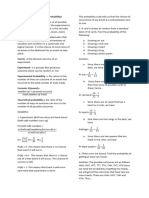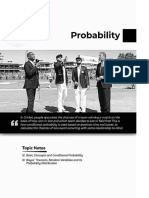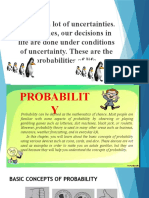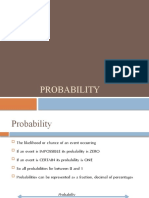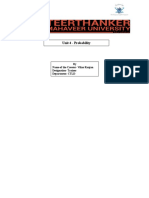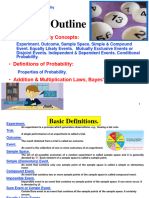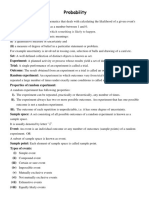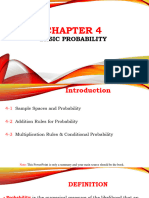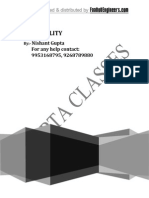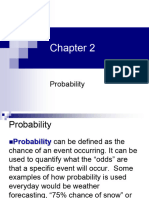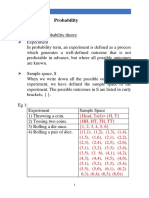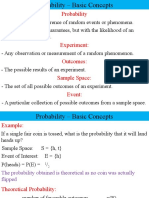Probability
Uploaded by
lemonbakery.vanProbability
Uploaded by
lemonbakery.vanS)xa s 5°87 4 74. This is not binomial because each time a tire is checked, there is one less tire left to check, Method 1 (by formula) 3 10 3 8y2 < Oftthe 10 tires, you want 3 of them ma 5 Method 2 (by reasoning) eee ae eer 0° 9° 8 15 8 chanced out of 10 of selecting good tires | 7 chances out of 9 of selecting good tires 6 chances out of 8 of selecting good tires 75. This is binomial because the probability does not change in each bankruptcy case. Method | (by formula) £Cu-(06}"(04)'+4C, 0.6) (0.4) +504 -0.6)(04)” = 1OL- osaasa Method 2 (by TI-83 calculator) 1 —binomedf (6, 0.6, 3) = 0.54432 Note: the TI-83 calculator method is explained in much more detail in the Statistics Unit. Copyright © by Crescent Beach Publishing ~All rights reserved. Cancopy © has raled that tis Book is not covered by thet Licensing greement. No part ofthis publication may be reproduced without explicit permission ofthe publisher 190 ¢ PROBABILITY ~ SOLUTIONS Theory and Problems for Senior High Math 76. This is binomial, Method 1 (by complementary formula) Plat least one 7) = 1 ~ P(no 7's) sys) =1-[°/4) (3) -o598 (fe) -e Method 2 (by TI-83 calculator) P(at least one 7) binompdf (5, —,0) = 0.598 1 e 77. This is not binomial because each time a t-shirt is selected the probability changes for the next selection Method | (by formula) ByYs = = =0.05779 969 20 4} © 0F20 tshirts Ken wants 4 Method 2 (by reasoning) Fy” * TE Buty the permutation principle, 2 white and 2 blue canbe arranged 4! 754 Spy = O ways, therefore, >. .6 9.05779 22 ae 20 19 18 17 78. This is not binomial because once a sock is selected the probability changes for the next selection a) Method 1 (by formula) OFBblack socks, Ken wants?» gC 2 o1 OF 18 socks, Ken wants? + gC Method 2 (by reasoning) 28 Bchoices outer 18> 2.2 © 7 choices outor17 = 2% = 0.183 18 17 3 b) Method 1 (by formula) Cyt eCat aly_ 49 PQ same colour) = = 8 03203 ‘@same colour) a s Method 2 (by reasoning) seat yas P(2same colour) = 2.246. 5.4.3.4 og 3093 1817-18 17-18 17 153 Copyright © by Crescent Beach Publishing — All ights reserved. Cancopy © has ruled that this book isnot covered by ‘ther licensing agreement. No part ofthis publication may be reproduced without explicit permission ofthe publisher. mt tt tee ee enema mn nnn nnnnnnmnnnessecsecccasaaamaiaimiaa ‘Theory and Problems for Senior High Math PROBABILITY — SOLUTIONS ¢ 191 79. This is binomial because the number of defective games does not change with any shipment Method 1 P25 good games) + P(24 good games) Cu (0.92)(0.08)" + 35C,4(0.92)*(08)! =0.3947 Method 2 (by TI-83 calculator) | — binomedf (25, 0.92, 23) 0.3947 80. This is not binomial because once a student is selected, the probability changes for the next pick. Method | (by formula) PQ U ofS, UBC, WU of 4) = SAX 301 = 250, Cs 3003 (08325 Method 2 (by reasoning) CERAM But bythe permutation principle, the 5 students canbe arranged 7, = 20 ways therefore, 2.4.3.5. 5.29 = 008325 15 141312 11 : wee 81,2) PCS right, 35 wrong) = oCy(5} [F] = 0.0299 3 or by TI-83 caleulator = binompdt (50 0.2 , 15) = 0.0299 b) Plat least 15 right) = P(1S) + P(16) + ...... + P(S0) = 1—[P(0)+ PU) + + PAY] by TI-83 calculator binomedf (50 , 0.2, 14) = 0.0607 Note: the TI-83 calculator method is explained in much more detail in the Statistics Unit Copyright © by Crescent Beach Publishing ~ All ight reserved. Cancopy © has ruled that this hook is mot covered by thelr lieensing agreement. No part ofthis publication may be reproduced without explicit permission ofthe publisher
You might also like
- Module 7 (Basic Concepts of Probability)No ratings yetModule 7 (Basic Concepts of Probability)7 pages
- Session 1 Basic Concepts and Principles in Statistics and Probability-Part 2No ratings yetSession 1 Basic Concepts and Principles in Statistics and Probability-Part 231 pages
- Course Instructors: 1. Dr. R. Archana Reddy 2. Mr. B. Ravindar 3. Dr. G. Ravi KiranNo ratings yetCourse Instructors: 1. Dr. R. Archana Reddy 2. Mr. B. Ravindar 3. Dr. G. Ravi Kiran22 pages
- LAS - Unit-05 - Study Material - F.Y.B.tech Sem-II 2022-23No ratings yetLAS - Unit-05 - Study Material - F.Y.B.tech Sem-II 2022-2344 pages
- Lecture 8 (Chapter 5) - Introduction To ProbabilityNo ratings yetLecture 8 (Chapter 5) - Introduction To Probability25 pages
- A Probability Is A Number Between 0 and 1, InclusiveNo ratings yetA Probability Is A Number Between 0 and 1, Inclusive13 pages
- NJC Probability Lecture Notes Student EditionNo ratings yetNJC Probability Lecture Notes Student Edition14 pages
- Probability: OR Probability Is The Extent To Which Something Is Likely To HappenNo ratings yetProbability: OR Probability Is The Extent To Which Something Is Likely To Happen6 pages
- Probability All Previous Year Questions PYQsNo ratings yetProbability All Previous Year Questions PYQs8 pages
- Introduction To Conditional Probability and Bayes Theorem For Data Science ProfessionalsNo ratings yetIntroduction To Conditional Probability and Bayes Theorem For Data Science Professionals12 pages






